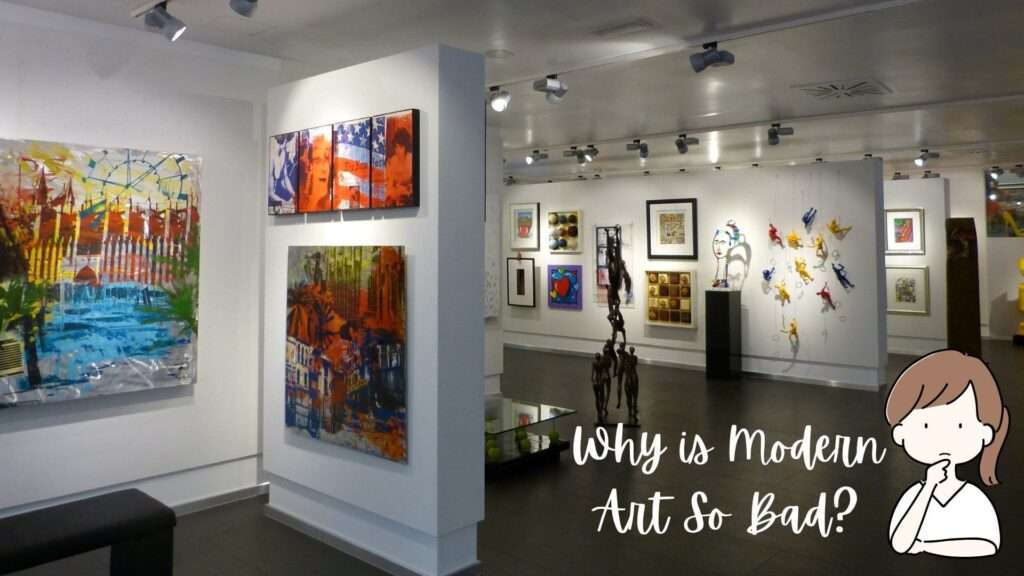
Modern art is often marked by its complexity, embracing ambiguity to engage audiences differently than past art movements. Unlike traditional styles that centered on precise techniques, modern art allows open interpretations, particularly evident in conceptual art pieces. Artists like Duchamp and Pollock created works that left audiences questioning their intentions, inviting deeper reflection on society and self. Despite critics who question why is modern art so bad at times, such art prompts individual reactions and cultivates dialogue. Therefore, these layered meanings allow viewers to explore subjective experiences within each piece.
What Traditional Art Brought to the Table?
Traditional art, rooted in classical art and fine art, established enduring techniques and values. Artists in classical art honed their skills through demonstrable art training, which focused on technical skill, realism, and detailed representation. This era emphasized balance, symmetry, and a commitment to high craftsmanship, ultimately shaping what many consider “good art” today.
Key characteristics of traditional art include:
- Emphasis on realistic representation, often mirroring scenes from life or nature.
- Skilled craftsmanship developed through formal training and structured approaches.
- Focus on universally relatable themes, e.g., love, heroism, and morality.
- Precise attention to detail, balance, and proportion in compositions.
- Use of classic materials like oils and marble, conveying timelessness and durability.
Additionally, traditional art prioritized themes that resonated universally, drawing from myth, religion, and nature, to create lasting pieces of art. Unlike many contemporary art forms, classical art often aimed to convey beauty and evoke admiration rather than provoke controversy.
How Modern Art Redefined Artistic Boundaries?
Modern art aimed to break away from traditional limitations, embracing abstract art, surrealism, and postmodern art. Artists like Jackson Pollock and Marcel Duchamp challenged the notion that art must adhere to classic forms or technical precision. Instead, they explored creativity as a process to express subjective emotions and ideas.
This approach welcomed new forms like performance art and conceptual installations. The art world also recognized that art could reflect individual perspectives rather than universal ideals, reshaping what constitutes art itself.
Thus, modern art redefined artistic boundaries by inviting audiences to question and interact with the experience of art.
The Role of Art Movements in Shaping Modern Art
Art movements like Impressionism, Cubism, and Abstract Expressionism significantly influenced modern art, each redefining art’s purpose and form. These movements questioned art’s traditional role, suggesting it could evoke subjective interpretations rather than convey fixed meaning.
For instance, Cubism introduced fragmented perspectives, allowing viewers to see multiple angles simultaneously, which contradicted traditional art’s singular viewpoints.
Similarly, Abstract Expressionism, marked by the works of artists like Mark Rothko, emphasized emotional intensity over detailed representation.
By breaking classical norms, these movements encouraged diverse approaches in the contemporary art world, fostering an environment where art could exist without traditional boundaries and expectations.
Common Criticisms: Why is Modern Art So Bad?
- Some critics argue that modern art lacks technical skill, focusing on concept over craft.
- People feel that abstract art often appears random, making appreciation difficult without context.
- Art institutions sometimes support pieces that seem absurd, e.g., objects taped to a wall.
- Comparatively, classical art shows evident skill, which many believe modern art cannot match.
- There’s a sentiment that modern art disregards traditional standards, making people dislike it.
- Others say that art has become overly commercial, prioritizing trends over meaningful expression.
- Some believe modern art caters to elite tastes, alienating general audiences from art appreciation.
Why Abstraction and Minimalism Took Center Stage
Abstraction and minimalism undeniably transformed theworld of modern art, emphasizing simplicity and subjectivity over traditional techniques. Rather than focusing on demonstrable art training, these movements embrace personal expression and leave art appreciation open to interpretation. People don’t like modern art as it often challenges traditional art forms and expectations, leading to divided opinions. However, this shift reflects a broader purpose of art—to evoke emotion and provoke thought. While good art was once rooted in realism, abstraction invites viewers to approach art objectively. Consequently, abstraction and minimalism continue to shape the art market and contemporary artists today.
The Rise of Digital Marketplaces for Modern Art
The rise of digital marketplaces has undeniably transformed how people approach art in the modern period. Platforms like Artsy, Saatchi Art, Etsy, and Amazon have made it easier than ever to experience art beyond traditional galleries. These marketplaces provide an accessible way to encounter new forms of art, even enabling a deeper engagement for those who previously felt detached from the world of modern art.
Moreover, social media integration allows artists to showcase art works to a global audience. While people pay high prices for gallery pieces, digital platforms make diverse collections more affordable and available to all, thus expanding the purpose of art in today’s world.
The Rise of Contemporary Art Galleries and Public Reception
Contemporary art galleries have evolved significantly, providing not just display spaces but also cultural hubs for modern art appreciation. These galleries emphasize new forms of expression, whether through traditional art forms or experimental installations. Additionally, they offer immersive experiences, inviting audiences to engage with art on a personal level.
Public reception to these galleries varies; some people love the bold creativity on display, while others find the works baffling or “bad art.” Despite occasional criticism, galleries play a crucial role in the art world, fostering discussions on art’s role and purpose, and challenging traditional notions of what constitutes art.
Thinking Beyond the Canvas: The Conceptual Nature of Modern Art
Modern art often emphasizes concept over technique, valuing ideas more than demonstrable art training or realistic representation. This shift away from realism to abstract and conceptual works leaves some audiences puzzled, occasionally sparking debates over whether modern art lacks skill or substance.
However, artists in the modern period often create with intention, aiming to provoke thought or societal reflection. Artworks by pioneers like Mark Rothko and Willem de Kooning illustrate this approach, prioritizing emotional response over visual accuracy.
The conceptual nature of modern art challenges viewers to approach art objectively, sparking diverse interpretations and redefining traditional expectations for art’s purpose.
Conclusion
Modern art has divided opinions, with many finding it difficult to appreciate compared to classical art. Unlike fine art, which requires technical skill and clear forms, much modern art emphasizes abstract ideas and subjective expression. Artists like Jackson Pollock and Marcel Duchamp challenged the traditional notion of what constitutes art, which led to contemporary styles that some find hard to understand. Art institutions continue to defend modern art, arguing its value lies in breaking norms. Yet, the debate remains: if “why is modern art so bad” persists, does modern art still fulfill its purpose? What role does art have for you?
FAQs
1. Why is modern art so bad?
Many find modern art lacks technical skill and clarity compared to classical art.
2. What defines “bad” modern art?
Some think it’s abstract or lacks meaning, making it hard to appreciate.
3. Does modern art lack meaning?
Some believe so, but others feel it allows personal interpretation and emotional resonance.
4. How has modern art influenced future art?
Modern art opened doors for new forms, encouraging further experimentation in art forms.
5. Why does modern art sell for high prices?
Art’s value is subjective, often set by collectors and the art market.



